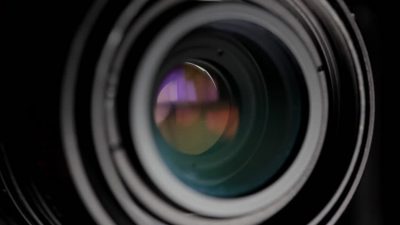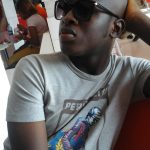By
Atanda Faruq Obatolu
Lamang Frank Muqtab, six feet one at eighteen, rigid with muscles and sporting a mustache, donned his backpack and brand new Nikon L830 Coolpix, the strap of which briefly touched his glasses and flung it off his face and on to the tiled floor. He bent over to pick it up and the camera, hanging down his neck now, lightly grazed the ground. Shit! He thought, bloody thing! Better put it where it’s safe! After re-donning his glasses, he took the camera off his neck very carefully, inspected it all around, as one might a malaised child, and put it in his bag. Yes, it was safe there! And he was set to leave.
Yesterday, when his mother had got him the camera at the mall in Ikeja, she’d looked at him somewhat wistfully and said: ‘Fifty-two thousand! And you are careless! Wo, if anything happens to it, you’ll see pepper.’ Now Lamang didn’t intend on letting anything happen to the camera, not because he feared that his mother could make good on her threat, but because he had a long and fanciful use for the device, after which it’d be replaced with a better model. But in the meantime, it had to serve him well like a king to his people. He had armed himself enough with article after article on how to take and make amazing shots, the rule of thirds, pattern in photography, leading lines, etc; as well as an interesting Instagram post by the novelist and photogtapher Teju Cole, who was working on a project called The Hive: a combination of street photography and literature, and whose work in both the photography and fiction departments had inspired him greatly.
Teju Cole was an interesting man of forty, born in America by parents – who were themselves born in Nigeria – raised in Nigeria and currently living in America. (To deviate a bit, Lamang had consciously unlearned the habit of using countries as adjectives when describing people, a mission he embarked upon after watching a talk by another novelist and photographer Taiye Selasi titled: ‘Don’t Ask Where I’m From; Ask Where I’m a Local.) Lamang had discovered Teju Cole about two years ago while reading about Adichie (he liked to read about writers) on Google. At the time, the mere fact that the man did photography alongside literature had instantly put him off. His naivety had led him to opine strongly that you either do literature and literature alone or forget it altogether. How could you do serious literature and still have time for other things? But after reading his first book – or second book, depending on how you saw it – Everyday is for the Thief, and then reading Open City last year, Lamang had decided that Teju Cole was the best contemporary African writer he knew. And photogtapher. Cole was simply a genius; an interviewer had once rightly called him the man who knew everything. And so he had begun to stalk the man on every social media possible: Twitter, Instagram, etc.
Lamang had only one mission that day and it was simply to shoot photos, although he’d told his mother that he was visiting a friend for an assignment (by the way, Lamang was a student of Yaba College of Technology). If she’d known that he planned to walk the streets of Lagos aimlessly, carrying his camera in his hands like a trophy, and thus running the risk of losing or damaging it, she’d have locked the gates and flushed the key down the toilet in a heartbeat. With his mother, it was always safer to lie. He started his walk from Yaba. There he shot four photos, viz;
1) A ‘blind’ beggar with sunshades siting on a culvert. (This interested him because the man’s head curiously followed a ‘bottomly’ endowed lady as she walked past him);
2) The intricacy of black and yellow buses that was the motor park;
3) A dirty, weeping lad that he saw on the road that linked Yaba to Ojuelegba;
4) A small group of smoking touts under the Ojuelegba bridge. (This almost cost him his life and camera, and he ultimately had to delete the photo).
From Ojuelegba, he walked all the way to Mushin, then back to Jibowu and soon Yabatech, shooting about two dozens photos. By the time he found his way to the University of Lagos, it was fast becoming evening. He’d only been there twice to see a friend in the Faculty of Law. He walked to the faculty now, hoping he might see his friend. He did not. And from there, he made it to the famous Lagoon Front, the entrance of which stood at the bottom of a long set of stairs. Standing on the top edge of that stairway and looking towards the water, he captured a nice vista of the Lagoon Front, balancing in the camera frame a vast, clear sea – which ran from left to right alongside the third mainland bridge – right above the greenery and the concrete and the students. He climbed down the stairs and into the Lagoon Front.
His first impression of the place was: nature. This was nature, nature, nature, everywhere. Although, once in a while, you saw a bit of civilization here and there, it was all generally nature: trees, and fallen leaves and grasses and crabs, not to mention even, the large body of water from which the place earned it’s name. Lamang made good use of his camera here. He was so excited, he wanted to capture everything altogether in one gargantuan frame, and then individually in separate frames. He shot the tall tress, short trees, thick grasses, mud, fallen leaves, falling leaves, etc. He must have toured the place for close to two hours. And eventually encountered a student who looked at him once and concluded that he was crazy. They talked for a while. Lamang said nature was beautiful. The student said he couldn’t care less. Lamang said but he should. The student said why should he waste his time loving nature when it could do him no good. Lamang said nothing. He wanted to say something deep and patronizing like: ‘The love of nature is the beginning of wisdom’, but he decided against it. So he said: ‘Photography is beautiful.’ And the student told him somewhat humorously to go shit on himself.
Lamang smiled. Gone were the days of his own ignorance. Two years ago, if you’d asked him to carry a camera and shoot nature, he’d have told you to go fuck yourself. Those days were over, thanks to Teju Cole. He was wiser.
At around six-thirty, Lamang bid farewell to his chat mate. Before he left the Lagoon Front, he took one final look at the place. That was when he saw it: the green disposable plastic plate, gliding gently across the lagoon. He raised his camera, took two shots and viewed them to confirm he’d captured well. He had. At that moment, his mind was like a perfectly sculpted image, with all contours and details vivid as the day. He had a fantastic train of thoughts, which he knew he must put to paper. That night, before he slept. Oh, but wasn’t this just what he’d been looking for all day? A picture with meaning? A certain bliss settled upon him. He took his exit.



No Comments Yet!
You can be first to comment this post!